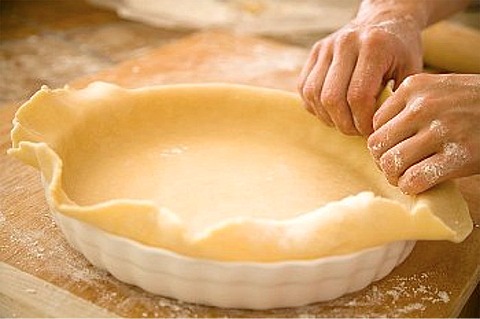
stock photo
“Boy, what a difference from the recipes that I have been using! It is excellent. Tender texture, fine flavor, no greasiness. This is my standard pie dough until further notice! I'm no longer interested in flaky crust recipes unless one comes along that is as good as the Perfect Pie Dough.” StanL, Premium Member.
PASTRY RECIPE HELP / LOW / REDUCED-FAT RECIPE HELP
INGREDIENTS
4 tablespoons (1/2 stick) unsalted butter, chilled
1 cup unbleached all-purpose flour or whole wheat white flour; spoon into measuring cup and level top
3 tablespoons sugar
1/4 teaspoon baking powder
1/8 teaspoon salt
1 large egg yolk
2 tablespoons ice water, plus more if needed
1/4 teaspoon cider vinegar or lemon juice, freshly squeezed
INSTRUCTIONS
1. Using the large holes of a box grater, shred the chilled butter onto a plate. Freeze for 10 minutes.
2. In a medium mixing bowl, whisk the flour, sugar, baking powder and salt to combine. Add the shredded butter. Using a pastry blender or two knives, cut in the butter until it resembles coarse cornmeal — no distinguishable pieces of butter should remain. (If you wish, use your fingertips to rub the butter into the flour mixture, but a pastry blender is much quicker. Be sure to use only your fingertips, not the palms, which are warmer. The butter must stay cold).
3. In another mixing bowl, thoroughly mix the egg yolk, ice water, and vinegar. Tossing the flour mixture with a fork, gradually stir in the liquid until the dough is thoroughly moistened but not wet, and clumps together. You may not need all of the liquid. To test the consistency, press the dough between your thumb and forefinger — it should just hold together. If it won't sprinkle additional ice water, 1 teaspoon at a time. Do not add so much liquid that the dough clumps into a solid ball — wet dough bakes into a tough pie crust.
4. Gather the dough in the bowl to bring the clumps together. Gather it into a thick disk (the dough will remain somewhat crumbly) and wrap it in waxed paper (waxed paper works better than plastic wrap, which can make the exterior or the dough sticky. Refrigerate until chilled, at least 1 hour and up to 8 hours.
5. Prepare the 9-inch ovenproof glass pie pan by generously spraying with oil.
6. To roll out the dough, unwrap and place it on a piece of waxed paper. Beat the dough with the rolling pin on its side, to soften it slightly. Cover the dough with a second piece of waxed paper and roll it into a 12-inch round about 1/8-inch thick. Work as quickly as possible so the dough doesn't get too warm. Patch and piece as necessary. Remove the top piece of waxed paper. If the dough sticks, place the dough round on a baking sheet and freeze for 5 to 10 minutes until the waxed paper can be lifted off. Let warm slightly so it won't crack when putting it in the pie pan.
7. Invert a prepared pie pan over the dough and quickly invert the pan and the dough together, letting the excess dough hang over the sides of the pan. Gently press the dough snugly into the corners of the pan. (If the dough cracks, just press the cracks together. Gaps can be patched with a scrap of dough). Peed off the waxed paper.
8. For pies, fold the overhanging dough into the pan so the folded edge is flush with the edge of the pan or trim the excess dough for tarts. Prick the dough all over with the tines of a fork.
9. Cover the pie crust with plastic wrap and freeze at least 1 hour or refrigerate overnight. The pie crust needs to be well-chilled before baking.
STORAGE
The crust can be refrigerated for about 3 days. It can be frozen if well wrapped, best used within a month.
Food Processor: If you wish, the flour and the other dry ingredients and butter can be combined in a food processor, but mix the rest of the ingredients in a bowl. Combine the flour, sugar, baking powder and salt in the food processor fitted with a metal blade. Pulse three times to combine. Add the butter and pulse until the mixture resembles coarse meal. Transfer to a medium bowl, and proceed with Step 3.
Per serving: calories, 106 (6 percent from protein; 50 percent from carbohydrates; 44 percent from fat); fat 5g (saturated 3g), cholesterol 34mg; protein 6g; carbohydrate 43 g; fiber 0.1g; sodium 37mg
The Healthy Oven Baking Book, by Sarah Phillips, Doubleday, 1999


